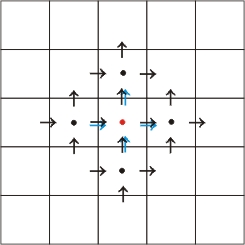FDTD : a complete model
FDTD is a detailed, wave-based sound propagation model that solves the Linearised Eulerian Equations (LEE). It can be considered as a complete model for outdoor sound propagation applications. Convection, refraction and scattering of sound waves by an inhomogeneous and moving atmosphere is modelled. The effect of arbitrary wind and temperature fields can be simulated, in combination with (multiple) reflections, (multiple) diffractions and scattering on objects. The interaction of sound waves with outdoor ground surfaces can be taken into account, either by using a porous-medium model or by simulating impedance planes. Very good absorbing boundary conditions (Perfectly Matched Layers, PML) were developed to simulate an unbounded atmosphere.
An important advantage upon the classical frequency-domain techniques is the ability to gain a broad frequency response by performing a single simulation in the time-domain model. Therefore, a pulse-like source needs to be modelled and a subsequent Fourier transform is used.
Importance of discretisation
The numerical implementation largely influences computational efficiency, numerical stability and accuracy. An improved scheme was developed for sound propagation applications outdoors for the typical (rather) low wind speeds encountered in the atmospheric boundary layer.
FDTD is characterised by its spatial and temporal discretisation. The efficient “staggered-in-space” schemes as commonly used in a non-moving and homogeneous atmosphere can still be used outdoors. The temporal discretisation needs special attention. An efficient but still accurate scheme called “Prediction-step staggered-in-time” (PSIT) was developed and analysed in depth (Appl. Ac. 68, 201-216, 2007).
Validation
The model has been intensively validated in various ways. Numerical results were compared to analytical solutions (see e.g. T. Van Renterghem, Phd thesis, 2003). Such analytical solutions to the wave equations in a moving and/or inhomogeneous atmosphere are available for simplified situations only. For a more thorough validation, wind tunnel experiments were performed (Act. Ac. Ac. 89, 764-778, 2003). Different configurations of single noise barriers and noise barriers on either side of a source were tested, at different wind speeds. The wind flow near the barriers was further complicated by introducing wind breaks (see Section : Trees to improve noise barrier efficiency in wind). Good agreement between numerical calculations and measurements was obtained.
Other successfull validation exercises (with real-life measurements) in non-moving media consist of personalized simulations of sound propagation in the ear canal (J. Acoust. Soc. Am., 125, 1479-1489, 2009), predicting the performance of porous materials (J. Acoust. Soc. Am., 134, 4599-4609, 2013), the simulation of the reflection ratio in urban street canyons (Build. Env., 97, 96-110, 2016), and predicting the effect of a berm in a complex multi-lane highway situation (Env. Mod. Software, 109, 17-31, 2018).
In addition, cross-validation with other established simulation techniques (like the boundary element method (BEM) and the pseudo-spectral time-domain (PSTD) method) were performed in various scenarios involving complex sound propagation (see e.g. Appl. Acoust., 121, 74-81, 2017 or "Road traffic noise reduction by vegetated low noise barriers in urban streets", T. Van Renterghem, M. Hornikx, Y. Smyrnova, P. Jean, J. Kang, D. Botteldooren, J. Defrance in Proceedings of Euronoise 2012).
Hybrid models
The degree of detail (and numerical cost) of FDTD is usually only needed in a limited part of the sound propagation domain. The coupling between FDTD and the (much faster) Parabolic Equation (PE) method is interesting in outdoor sound propagation applications. PE assumes one-way sound propagation (from the source to receiver), taking into account range-dependent refraction of sound and impedance planes. Large step sizes are allowed in horizontal direction (up to several wavelengths). An application of interest is a typical traffic noise situation. Computational efficiency can be largely improved by a coupled FDTD+PE model (Act. Ac. Ac. 91, 671-679, 2005), without losing accuracy. In this way, advantageous aspects of different models are combined to limit computational resources.
Figure 1
Positions of the acoustic pressures (dots), the acoustic velocity components (black arrows) and background flow velocity components (blue arrows), for updating the central (red) pressure node in a moving medium. In a staggered-in-space grid, acoustic pressures and velocities are shifted in space. This low-order scheme has a limited stencil which makes the implementation of boundaries easier, and the use of computer memory more efficient.

Figure 2
Schematic representation of the one-way coupling between FDTD and PE, in a typical traffic situation. The interface between both models consists of an array of acoustical pressures. The detailed model, FDTD, is used in the complex source region, while the less detailed model, PE, is used for long range sound propagation.
